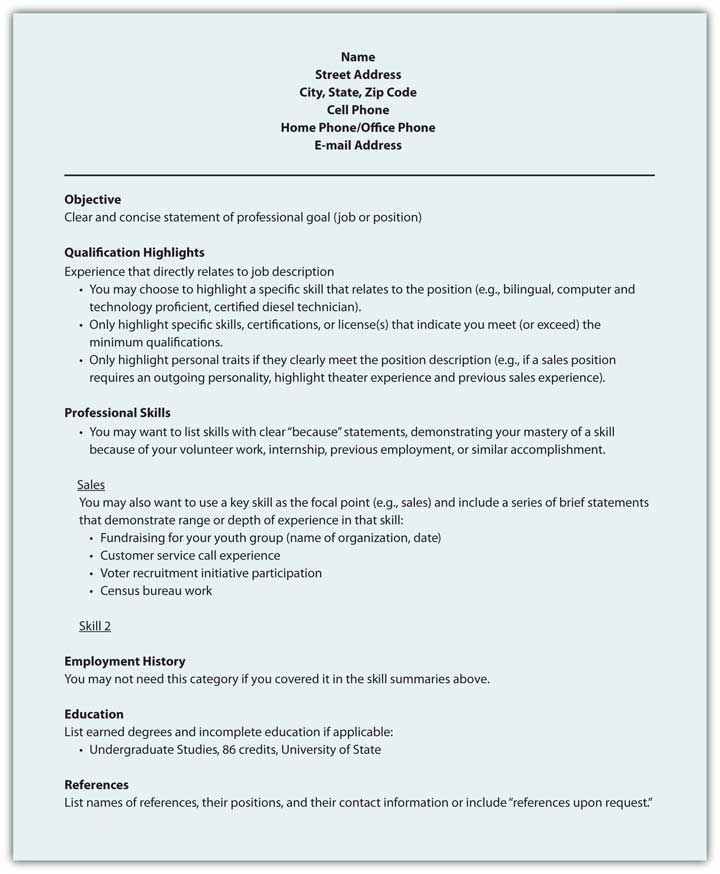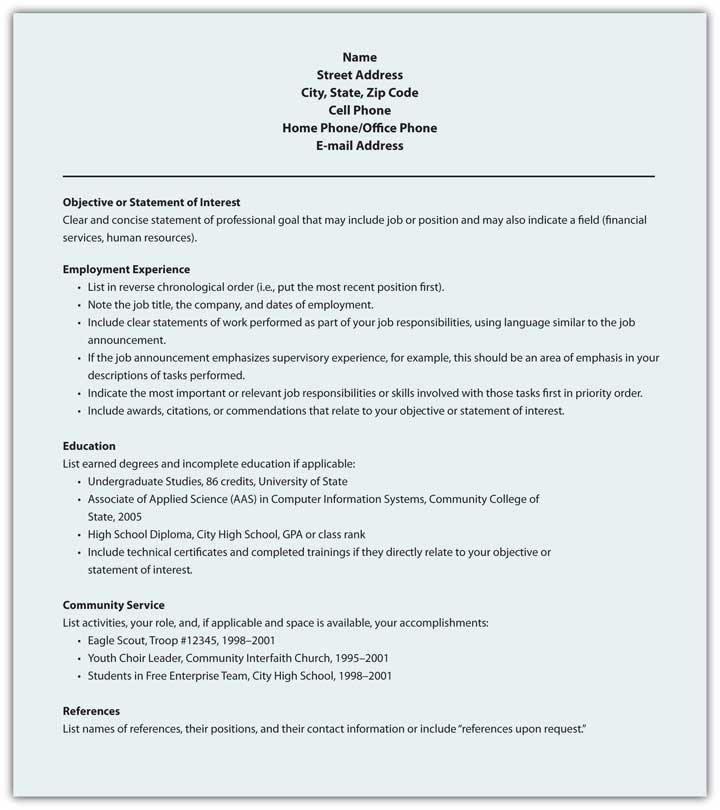8.2: Resumes
A resume is a document that summarizes your education, skills, talents, employment history, and experiences in a clear and concise format for potential employers. The resume serves three distinct purposes that define its format, design, and presentation:
- To represent your relevant professional information in writing
- To demonstrate the relationship between your professional information and the problem or challenge the potential employer hopes to solve or address, often represented in the form of a job description or duties
- To get you an interview by clearly demonstrating you meet the minimum qualifications and have the professional background needed to help the organization meet its goals
Regardless of the format, employers have expectations for your resume. They expect it to be clear, accurate, and up to date. This document represents you in your absence, and you want it to do the best job possible. You don’t want to be represented by spelling or grammatical errors, as they may raise questions about your education and attention to detail. Avoid providing potential employers with an easy excuse to toss your resume at the start of the process. Do your best work the first time. Table 4.9.1 highlights some common types of resumes.
Table 8.2.1 Common Types of Resumes
| Type | Function | Advantage | Disadvantage |
|---|---|---|---|
| Chronological | Chronological resumes (which list items in reverse time order) focus on work history. | Demonstrates a consistent work history | It may be difficult to highlight skills and experience. |
| Functional | Functional resumes (also called competency-based resumes) focus on skills. | Demonstrates skills that can clearly link to job functions or duties | It is often associated with people who have gaps in their employment history. |
| Combination | A combination resume lists your skills and experience first, then employment history and education. | Highlights the skills you have that are relevant to the job and provides a reverse chronological work history | Some employers prefer a reverse chronological order. |
| Scannable | A scannable resume is specifically formatted to be read by a scanner and converted to digital information. | Increasingly used to facilitate search and retrieval, and to reduce physical storage costs | Scanners may not read the resume correctly. |
Main Parts of a Resume
Resumes have several basic elements that employers look for, including your contact information, profile and objective/ goal, education and work experience, and so on. Each resume format may organize the information in distinct ways based on the overall design strategy, but all information should be clear, concise, and accurate. The content in your resume should be carefully selected to present the best, most applicable qualifications for a particular employer (the company and position for which you are applying) or purpose (attending a career fair).
Contact Information
This section is often located at the top of the document. The first element of the contact information is your name. You should use your full, legal name even if you go by your middle name or use a nickname. There will plenty of time later to clarify what you prefer to be called, but all your application documents, including those that relate to payroll, your social insurance number, background checks, transcripts, certificates, or degrees, should feature your legal name. Other necessary information includes your phone number and email address. For business purposes, do not use an unprofessional email address like teddybears@….com. Create a new e-mail account if needed, with an address suitable for professional use. If you have more than one phone number at which you can be reached, list the one you’re most likely or most easily able to answer. (Don’t make it confusing for an employer to guess at which number to call you.)
Profile and Objective
This is one part of your resume that is relatively simple to customize for an individual application.
Your Profile should highlight your most relevant qualifications for the job (based on the job ad and your education, prior work experience, etc.). Your profile should be carefully adapted to the job ad and not a random list of skills.
Your objective should reflect the audience’s need to quickly understand how you will help the organization achieve its goals. An example of an objective is shown in Figure 8.2.1. Please note that you should name the company, the position, and specify what you could do for them. Don’t say something vague and self-centred such as “To gain a well-paying job in a respectable bank.” Doing that would show them, among other things, that you don’t understand the rules of the game — and it might eliminate you from the competition immediately.

Education
You should list your education in reverse chronological order, with your most recent degree/ diploma/ certificate first. List the school, credential type (e.g., diploma, certificate, degree), and the full credential name. Don’t use abbreviations for your university/college or program. For example, if you’re completing a BBA-Accounting, spell it out in full (Bachelor of Business Administration in Accounting). If you went to a college or university that may not be known in the area where your potential employer is located, include the city and country alongside the name of the school. List your GPA or your average for the last year if high. (You might have to convert your average into percentages if your school used a different grading system than that used in the country/ area where you are applying for a job.)
If you have a degree/ diploma/ certificate in progress, start with that and provide the projected graduation date.
Work Experience
List, in reverse chronological order, your employment history, including the positions, companies, locations, dates, duties, and skills demonstrated or acquired. You may choose to use active, descriptive sentences or bullet lists, but be consistent. Emphasize responsibilities that are relevant to the specific job for which you’re applying, but don’t let emphasis become exaggeration. This document represents you in your absence, and if any information is false, at a minimum you could lose your job. Be specific, be precise, and quantify details whenever possible. For example, instead of saying “managed employees during the night shift,” you could quantify that statement by saying “supervised 8 employees during 9-hour overnight shifts.” Ideally, start each item with an action verb. Use the present tense to describe tasks and accomplishments for positions you currently hold and the past tense to describe positions you no longer hold.
Other Relevant Qualifications
If you have received awards or honours; given presentations; published papers or other materials; or have other qualifications of note and relevance to the position for which you’re applying, you can list these in an appropriately named section on your resume. Don’t include a list of your personal interests or hobbies unless they relate directly to the field or it could be argued that they bolster your transferable skills. If you are wondering whether or not to include a piece of information, focus on the audience’s needs. Will they find this information valuable in making a decision about you as a candidate? Does it reveal something important about your skills, interests, and qualifications? Does it reveal something new about you that is not already revealed in your resume?
References
You may choose to include references at the end of your resume. If you do, provide individuals’ full names, the company name, the position, and full contact information. If you are invited to an interview, three references are typically expected. They can be former professors, managers, etc. (ideally, people with whom you worked in a variety of roles).
Additional Resume Strategies
Length
Your resume should be 1-2 pages long. Since you are pursuing a graduate certificate at Fanshawe and must have prior degrees/ diplomas and probably also some work experience, a 2-page resume would be reasonable. Don’t artificially extend your resume (through wordy statements, larger than necessary font size, unnecessary spacing). Also, don’t exceed two pages unless you have a really long work history and you need to provide specific, relevant information directly related to the position sought. The person reading your resume may be sifting through many applications and will not spend time reading several extra pages if the content is not directly relevant.
Use Key Words
Just as there are common search terms and common words in relation to each position, job description, or description of duties, your resume should mirror these common terms when and where appropriate.
Follow Directions
If a job description uses specific terms, refers to computer programs, skills, or previous experience, make sure you incorporate that language in your resume (assuming you have those skills or experience). By mirroring the employer’s language and submitting your application documents in accord with their instructions, you convey a spirit of cooperation and an understanding of how to follow instructions.
Make it Easy to Read
Make sure your resume is easy to read. Use white space between sections. Use emphasis (such as bolding, italicizing, underlining, or all caps) consistently to draw attention to headings or things of note, but avoid using multiple types of emphasis at one. For example, don’t bold, underline, and italicize the heading for your work experience section. Choose an easy-to-read font that is typically used in business documents, such as Times New Roman, Arial, or Calibri. Avoid using less common font types, which may be difficult to read. A font size of 11 or 12 is easier to read for most people. Be consistent and purposeful in the visual design of your resume. Align bullet points consistently. Use the same types of bullet points in your resume. Align your resume content consistently. Remember that whoever will be reviewing resumes will likely be looking at many documents in a row and may have to work quickly!
Resume Templates
A template of a chronological resume is shown in Figure 8.2.2. Remember to add a Profile to your Objective (based on the job ad and your skills).
Whereas the chronological resume focuses on employment history, a functional resume, as shown in Figure 8.2.3 below, highlights skills. (Again, preface your Objective with a short Profile.)

Attributions
This chapter contains material taken from Chapter 9.5 “Resume” in Business Communication for Success (used under a CC-BY-NC-SA 4.0 International license) and “Preparing job application materials” in A Guide to Technical Communications: Strategies & Applications by L. Hall and L. Wahlin (used under a CC-BY-NC 4.0 International license).


